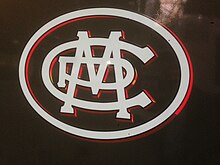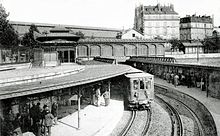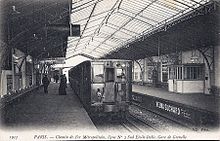Compagnie du chemin de fer métropolitain de Paris
The Compagnie du chemin de fer métropolitain de Paris ( CMP ) was a French railway company that operated most of the metro lines in Paris in the first half of the 20th century . The company was based on the Quai de la Rapée.
prehistory
The engineer Jean-Baptiste Berlier had already submitted a project for underground electric trams to the city council of Paris in 1887 . Their route should lead from the Bois de Boulogne in the west of the city under the Avenue des Champs-Élysées and the Rue de Rivoli to the Bois de Vincennes on the eastern city limits. On July 4, 1892, the city gave the permit, but the State Council objected. In 1895 the city was able to assert itself against the state and in 1898 began building a standard-gauge underpaved railway , the route of which largely followed the route proposed by Berlier. Line A was built between the endpoints Porte Maillot and Porte de Vincennes , when it was commissioned, it was given line number 1 .
History until 1930
A law of March 30, 1898 stipulated that the tunnels, cuts, viaducts and platforms should be built by the city of Paris. The future operator was responsible for building the workshops and power plants, laying the tracks, purchasing the vehicles and the track equipment. A 65 km long network consisting of six lines A to F was planned for the transport of passengers and their hand luggage. The trains should be operated electrically. The concession went to the Compagnie du chemin de fer métropolitain de Paris, a joint venture between the Établissements Schneider in Le Creusot and the Compagnie générale de traction , for 35 years .
Construction of the first line began that same year. Under the direction of the engineer Fulgence Bienvenüe , who had already been appointed head of the project in 1896, it should be completed by the start of the world exhibition on April 14, 1900. Coming from Porte de Vincennes, the line at the Etoile metro station should fan out into three branches that led to Porte Maillot, Porte Dauphine and Trocadéro . In the end, however, this “London model” was abandoned; the latter two routes became the nucleus of today's lines 2 and 6 . The western terminus of line 1 was Porte Maillot station until 1937.
Despite all efforts, the planned opening date could not be kept. After all, the 10.3 km long Line 1 was put into operation during the ongoing World Exhibition on July 19, 1900. By December of that year the number of almost four million passengers had already been reached. Five more lines had been completed by 1910. The resulting network was laid out in such a way that no point in the city was more than 400 m away from a subway station and a maximum of two transfers had to be made to reach the destination station. The flooding of the Seine in January 1910 flooded parts of the Métronetz and paralyzed long stretches of traffic, only line 2 could continue to run in full. The last section of line 6 only went back into operation after a three-month break.
On November 5, 1910 - at the same time as Line 7 was opened - the CMP competed with the Société du chemin de fer électrique souterrain Nord-Sud de Paris (North-Sud). On that day, it opened its first line A, a north-south connection from Notre-Dame-de-Lorette to Porte de Versailles . Unlike the CMP, the new company financed and built its own lines. The CMP viewed the Nord-Sud as an unpleasant competitor, especially since their new line, like the CMP line 4 completed in the same year, covers the districts of Montmartre and Montparnasse - albeit on different routes - connected with each other. It was only after long negotiations that a compromise between the two networks was found with regard to transferring passengers, which obliged the north-south to make annual payments of 150,000 francs to the CMP.
At the beginning of the First World War , the metro network - including the two north-south lines - had grown to 91 km. The CMP operated the following lines in 1914:
- Line 1: Porte Maillot - Porte de Vincennes
- Line 2: Porte Dauphine - Nation
- Line 3: Porte de Champerret - Gambetta
- Line 4: Porte de Clignancourt - Porte d'Orléans
- Line 5: Étoile - Place d'Italie - Gare du Nord
- Line 6: Place d'Italie - Nation
- Line 7: Opéra - Louis Blanc - Porte de la Villette or Pré-Saint-Gervais
- Line 8: Porte d'Auteuil - Opéra
The war initially had a disruptive effect on the operation of the Métro, as many employees were drafted. However, the situation normalized within a few months, mainly through the use of women. However, the ambitious pre-war construction projects could not be implemented, at CMP only a short extension of the route by two stations went into operation.
The first post-war years were marked by financial difficulties on the part of the operator as well as the passengers. In 1921 the CMP therefore lost its financial autonomy in favor of the city of Paris, which in turn paid for the deficits. In addition, the Métro was expanded again: routes were extended and lines 9 and 10 created. On January 1, 1930, the Nord-Sud was incorporated into the CMP, which from then on was only called "Chemin de fer métropolitain de Paris" while retaining the abbreviation. In 1931, lines A and B of the former north-south were renamed lines 12 and 13.
Chemin de fer métropolitain de Paris
In 1930 the middle sections of lines 1, 3, 4, 7 and A were the busiest. All lines ended at or near the city limits. In 1928, extensions to some suburbs were decided, the first of which was the line 9 to Pont de Sèvres in Boulogne-Billancourt in February 1934 . By 1939, six more such extensions could be put into operation. In addition, in 1938 the CMP took over the suburban line Ligne de Sceaux from the Paris terminus in Luxembourg to Massy from the Compagnie du chemin de fer de Paris à Orléans (PO).
The outbreak of the Second World War led to temporary interruptions of several lines due to a lack of personnel due to conscription. Numerous underground stations were closed, some of them only reopened after decades or not at all. During the German occupation of the city in 1941 , the Vichy regime brought about the merger of the Société des transports en commun de la région parisienne (STCRP), which operated the trams and buses in the Seine department , with the CMP under the leadership of the latter. At the same time, the French state took over the role that the city of Paris had previously played in the CMP.
The operation of the Métro suffered from bomb attacks and power cuts in those years. Nevertheless, in October 1942, two new route sections, each with two stations, were put into operation. In May 1944, line 11 , which was opened in 1935, was confiscated by the Wehrmacht , which partially dismantled the tracks and relocated war-important operations into the tunnels. Only seven and a half months after the liberation of Paris could operations on this line be resumed.
The End
The fact that the leadership of the CMP had behaved in a conciliatory manner towards the authorities of the German occupiers led to their removal by the French government on January 3, 1945. A provisional administration (Administration Provisoire des Transports Parisiens; APTP) was set up, which was faced with difficult tasks. The return of the numerous prisoners and displaced persons who had survived, and the shortage of buses - the trams had been abolished in Paris in 1937 - led to an unprecedented high of 1.6 billion passengers in 1946. With a law of March 21, 1948, the ATPT was replaced by the newly created state-owned company Régie autonome des transports Parisiens (RATP).
Remarks
- ↑ The trains coming from Opéra alternated between Louis Blanc and Porte de la Villette and Pré-Saint-Gervais
Web links
- Early documents and newspaper articles on the Compagnie du chemin de fer métropolitain de Paris in the 20th century press kit of the ZBW - Leibniz Information Center for Economics .
Individual evidence
- ^ Mark Ovenden: Paris Underground - The maps, stations, and design of the métro . Penguin Books, New York 2009, ISBN 978-0-14-311639-4 , pp. 173 .
- ↑ a b c Jean Tricoire: Un siècle de métro en 14 lignes. De Bienvenüe à Météor . 2nd Edition. La Vie du Rail, Paris 2000, ISBN 2-902808-87-9 , p. 22 .
- ↑ Jean Tricoire: op. Cit. , P. 30 f.
- ↑ Jean Tricoire: op. Cit. , P. 15 f.
- ↑ Jean Tricoire: op. Cit. , P. 17.
- ↑ a b Jean Tricoire: op. Cit. , P. 20.
- ↑ Jean Tricoire: op. Cit. , P. 21.
- ↑ Jean Tricoire: op. Cit. , P. 34.
- ↑ Jean Tricoire: op. Cit. , P. 197.
- ↑ Jean Tricoire: op. Cit. , P. 210.
- ↑ Jean Tricoire: op. Cit. , P. 223.
- ↑ Jean Tricoire: op. Cit. , P. 240 f.
- ↑ Jean Tricoire: op. Cit. , P. 23.
- ↑ a b Jean Tricoire: op. Cit. , P. 24.
- ↑ Le tramway en Île-de-France (pdf) at stif.org, accessed on June 22, 2017
- ↑ Jean Tricoire: op. Cit. , P. 25.
- ↑ Jean Tricoire: op. Cit. , P. 26.



